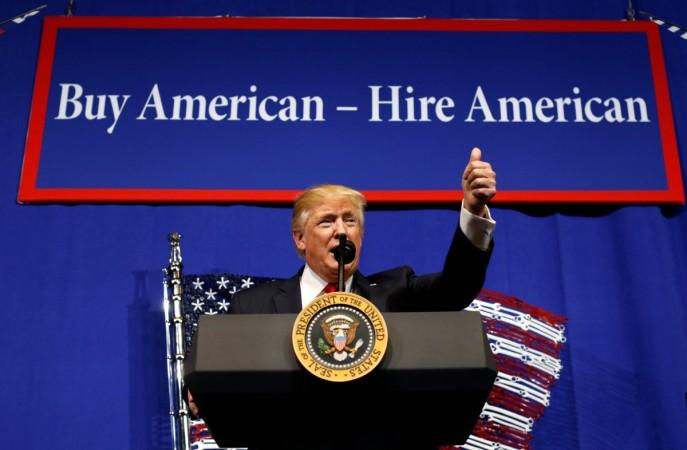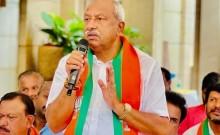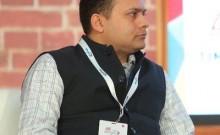
On September 19, 2025, U.S. President Donald Trump announced a $100,000 annual fee on H-1B visa applications, effective midnight EDT September 21, 2025, transforming the landscape for Indian professionals who hold 71–73% of these visas (207,000 in FY2024). Framed as curbing "abuse" to prioritize American workers, this policy—coupled with potential outsourcing taxes and broader immigration reforms like the $1M "gold card" visa—has sparked a polarized debate in India. Pro-government voices hail it as a "masterstroke" to reverse decades of brain drain, while critics, led by Congress leader Rahul Gandhi, decry it as a diplomatic failure exposing India's over-reliance on U.S. markets.
With 100,000–200,000 annual returnees projected, India's $283 billion IT sector and broader job market face a dual-edged sword: a potential $50 billion GDP boost by 2030 or a short-term unemployment crisis exacerbated by AI-driven job shrinkage. This op-ed synthesizes diverse data, X posts, expert analyses, and political narratives to assess the impacts, imperatives, and structural challenges, offering a holistic roadmap for India to turn adversity into opportunity.
H-1B's Role and India's Vulnerability
The H-1B visa has been a lifeline for Indian IT professionals, engineers, and doctors, with firms like TCS (5,505 approvals), Infosys (2,004), and U.S. giants like Amazon (10,044 in H1 2025) relying heavily on Indian talent. India's IT exports, generating $283 billion (60% from outsourcing), and $129 billion in remittances ($32 billion U.S.-sourced) underscore this dependency. However, historical policies under Congress-led governments, criticized for "license-raj" and corruption, drove brain drain, pushing talent westward. Modi's critics, including Gandhi, argue that his "hugplomacy" failed to secure safeguards despite 2017 warnings about U.S. market risks, leaving India exposed as stocks wobble and NASSCOM warns of "chaos."
The fee hike, alongside potential HIRE Act outsourcing taxes, threatens 13,000 immediate IT jobs and up to 3 million if outsourcing is curtailed. The one-day implementation deadline (September 21) triggered chaos—300% flight surges, stranded families (e.g., for weddings), and mid-air turnarounds. X posts lament shattered "American dreams" and "divorce surges" from forced returns, while Reddit warns of a "bloodbath" for foreign medical graduates (FMGs) awaiting green cards.
Positive Impacts: A Potential Brain Gain Revolution
Despite the upheaval, the policy could reverse India's brain drain, channeling U.S.-honed skills in AI, cloud, and data science into its tech hubs (Bengaluru, Hyderabad). NASSCOM projects a 10–20% R&D boost, echoing the 1990s software boom driven by IIT alumni. Returnees like Flipkart and Zomato founders demonstrate the potential: 72 Indian-founded U.S. unicorns ($195 billion valuation, 55,000 jobs) suggest a startup surge, with McKinsey forecasting 1 million returnees sparking 50,000+ startups and 2–3 million indirect jobs by 2030. Health tech alone could yield 50,000 startups by 2025.
Economically, returnee investments could add 1–2% to GDP via SME lending, offsetting a $10–20 billion remittances dip. Global Capability Centers (GCCs) are expanding, absorbing jobs domestically as offshoring grows. X users are optimistic: "America's loss is India's gain; build MIGA, not MAGA." Policy proposals like compulsory 5-year service for IIT/IIM graduates (taxpayer-funded) align with Modi's Aatmanirbhar Bharat, potentially anchoring talent to fuel high-value sectors like EVs and biotech, projected to add 1 million roles.
Negative Impacts: Job Market Shocks and AI Synergies
The immediate fallout is dire. India's urban youth unemployment (18%, CMIE 2025) could spike 2–3% as 100,000+ returnees flood Tier-1 cities, squeezing mid-level hiring. Returnees' 20–50% higher salary demands (vs. stagnant domestic wages) risk 10–20% wage cuts and underemployment for "overqualified" professionals, with 30% disillusioned within a year (LinkedIn). The IT sector faces a $1.3 billion cost surge, slashing TCS/Infosys/Wipro profits by 7–10% and threatening 500,000 BPO jobs. X posts warn: "Shrinking margins + AI layoffs = Indian giants can't absorb 10% of returnees."
AI exacerbates this. Globally, AI displaced 14% of workers (77,999 tech layoffs in 2025), with India's IT/BPO facing 20–25 million job losses by 2030 (Bank of Baroda). Routine coding and entry-level roles (e.g., data entry) are vanishing, transforming mid-level jobs. Returnees compete in this shrinking pool, with Reddit noting a "bloodbath for FMGs" and X predicting: "AI + returnees = end of middle class." Economic Survey 2024–25 warns of "protracted" displacement, particularly for low/mid-wage workers.
Structural Challenges: Barriers to Harnessing Talent
India's ability to absorb returnees is hampered by systemic issues:
Reservations: The 49.5% quota in jobs and education limits merit-based hiring, especially for general-category returnees. X users call it "feudal," noting elite returnees widen urban-rural divides, mirroring the Philippines' 5–7% inequality rise post-OFW returns.
Low R&D Budgets: India's Gross Expenditure on R&D (GERD) is 0.7% of GDP ($13,000 crore FY25) vs. China's 2.4%, with private sector contribution under 30%. Low utilization (61–72%, DST/DBT) and delays in stipends stifle innovation. X: "No vision, no R&D."
Weak Innovation Landscape: Over-reliance on outsourcing leaves India vulnerable to AI and policy shocks. Higher Education Institutions (HEIs) are underfunded, and societal push for science and technology lags. The ANRF Act is promising but needs equitable funding distribution.
Other Hurdles: Reverse culture shock (25% turnover), bureaucratic inefficiencies, and infrastructure strain (schools, hospitals in tech hubs) deter integration. X: "Where are jobs? Hire only cheap labor." Remittances losses ($5–20 billion) and stock market wobbles (Nifty IT down 1–5%) add pressure.
Imperatives: A Multi-Faceted Strategy for Resilience
To convert this crisis into a catalyst, India must act decisively:
- Create High-Value Jobs: Shift from outsourcing (60% exports) to product-led growth in AI, EVs, and biotech, potentially adding 1 million roles. MeitY's target to retrain 40–45 million workers by 2025 is critical, leveraging returnees' skills for AI/ML roles (9% job growth projected). WEF notes AI could create 12 million net jobs globally by 2025.
- Policy Reforms: Implement tax breaks (Startup India 2.0), "reverse visas" (Singapore model), and housing in tech corridors. A 5-year compulsory service for IIT/IIM graduates could anchor talent, while anti-corruption measures and capital access fast-track startups. X: "Build own giants or get crushed."
- R&D Investment: Raise GERD to 2% of GDP, mirroring China's model, with private-sector incentives. ANRF must prioritize applied research in AI/biotech to absorb returnees. X: "Wake-up call; build India-first LLMs."
- AI Integration: Bridge skill gaps via apprenticeships (83% Indians open to AI delegation). Wipro's mentoring model could boost productivity 15%, offsetting job shrinkage. GCCs must expand to absorb talent domestically.
- Market Diversification: Reduce U.S. reliance (28% remittances) by targeting UAE, Canada, and Singapore. X: "Offshoring accelerates via GCCs." Negotiate carve-outs in U.S. trade talks to protect IT exports.
Political Narratives: A Polarized Divide
The BJP frames the fee as a "blessing," reversing Congress-era brain drain and aligning with Modi's self-reliance vision. X: "Adversity creates opportunity; compulsory service for IIT grads." Conversely, Congress and Rahul Gandhi slam Modi's "weak diplomacy," noting accelerated brain drain (record student outflows, citizenship renunciations) and ignored 2017 warnings. Kharge calls it an "insult to Indians," while X posts mock "hollow slogans" and "selfie-diplomacy." Industry voices like NASSCOM urge transition time, warning of U.S. innovation losses (75% of Magnificent 7 engineers are H-1B). U.S. pro-Trump sentiment sees it as ending "cheap labor fatigue," but Reddit warns: "Jobs to Singapore; no U.S. wins."
Global and Human Dimensions
Globally, talent is shifting to Canada, UAE, and Singapore, with Mexico/Poland gaining offshoring. The U.S. risks losing its edge (66% Silicon Valley foreign-born; 46% Fortune 500 H-1B-driven). Human stories are stark: Families face loan losses from U.S. education, divorces from forced returns, and stranded professionals (e.g., for Raksha Bandhan). X: "Chutiyas calling it blessing? Families shattered." Legal challenges may block the proclamation, with attorneys citing "ethnostate" bias and executive overreach.
Seizing the Moment or Sinking in Chaos
India stands at a crossroads. The H-1B fee hike could fuel a $50 billion GDP surge by 2030, transforming India into a global tech hub via startups and high-value sectors. Yet, without urgent action, upskilling, R&D boosts, reservation reforms, and diversification, short-term shocks (2–3% unemployment spike, $5–20 billion remittances loss, AI-driven job cuts) risk inequality and disillusionment. Structural barriers like low R&D (0.7% GDP) and quotas threaten to turn "brain gain" into "brain waste." X captures the stakes: "Adapt or get crushed." India must harness this crisis, leveraging returnees' skills and Modi's Aatmanirbhar vision to build a resilient, innovative economy or face a lost decade.
[Major General Dr Dilawar Singh is an Indian Army veteran who has led the Indian Army's Financial Management, training and research divisions introducing numerous initiatives therein. He is the Senior Vice President of the Global Economist Forum AO ECOSOC, United Nations and The Co President of the Global Development Bank.]

















